What are Savannahs? - Characteristics (
Personality -
Verbalizations -
Appearance )
History -
Reproduction and Genetics -
Health Considerations -
Ownership Laws -
About the Serval

------------------ / THE SAVANNAH \ ------------------
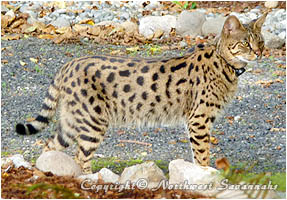 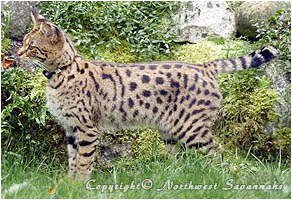
What are Savannahs?
The Savannah is a tall, slender, graceful hybrid breed resulting from the mating of the African serval and domestic cat. The goal of the Savannah breeding program is to create a large domestic cat with the exotic look and best personality traits of the serval mixed with the dependable temperament of the domestic.
Characteristics - Personality
Savannahs are friendly, curious, intelligent, playful and energetic. They bond tightly with their family and will greet you at the door and follow you around the house giving frequent head butts or an unexpected pounce. Some Savannahs are friendly with new people, and other cats and dogs, while others may run and hide.
They are easily leash-trained using a "walking jacket," can be trained to play "fetch," love heights, and enjoy water and might occasionally join you in the shower. They are NOT lap cats. They prefer to be near you, but not held.
Most Savannahs are great jumpers, enjoying a quick trip to the top of doors, refrigerators and high cabinets. Some can leap about 8 feet high from a standing position. Savannahs are very inquisitive and have been known to get into all sorts of things; they often learn how to open doors and cupboards, and anyone buying a Savannah will need to take special precautions to prevent them from getting into areas they you donít want them into.
Characteristics - Verbalizations
Many Savannahs inherit the serval tendency to hiss. This is not a sign of aggression, warning or anger, but simply a verbalization. They hiss when they are happy, angry or playful, but mostly because they like the sound. They may also chirp like their serval father, meow like their domestic mother, or do both, producing sounds which are a mix of the two. Chirping, when present, is observed more often in the higher percentage Savannahs.
Characteristics - Appearance
Because of the tall legs and long body the Savannah appears much larger and heavier than they actually are. The first (F1) and second (F2) generations are the largest due to the genetic influence of the serval with males ranging between 15 and 25 pounds (occasionally to 30 pounds). Females Savannahs range between 9 and 17 pounds and either gender of later generations between 8 and 17 pounds. Early generations range from about 16-18 inches high at the shoulder and 22-24 inches long from chest to rump. The random factors in Savannah hybrid genetics can result in a wide variation in size and physical characteristics, even in the same litter.
The Savannah should have as many of the following physical characteristics as possible: striking dark spots, large "ocelli marked" ears (a central light band bordered by black, dark grey or brown giving an eye-like effect) and a fluffy three-quarter length tail with black rings and solid black tip. The eyes should have a "boomerang" shape with a slightly hooded brow to protect them from harsh sunlight. Black or dark "tear-streak" or "cheetah tear" markings should run from the corner of the eyes down the sides of the nose to the whiskers. Their head should be taller than it is wide and they should have a long slender neck.
  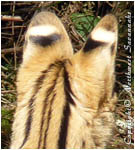  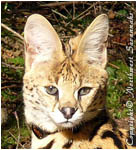  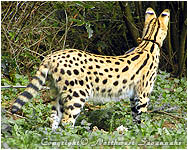
 dark spots dark spots ocelli marked ears ocelli marked ears tear streaks tear streaks 3/4 length tail 3/4 length tail
The base color of a Savannah is strongly influenced by the breed of cat used for the domestic cross. Early generations have some form of dark spotting on a lighter warm colored coat. The International Cat Association (TICA) breed standard calls for brown spotted tabby (cool to warm brown, tan or golden with black or dark brown spots), silver spotted tabby (silver coat with black or dark grey spots), black (black with black spots), and black smoke (black tipped silver with black spots), but occasionally snow, blue and other diluted colors are produced as well as pattern variations such as the classic or marble.
------------------ / HISTORY \ ------------------
The first known Savannah was born to breeder Judee Frank on April 7, 1986 when a domestic cat gave birth to a kitten sired by an African serval. This F1 (first generation hybrid cross) was the first on record. This unusual female kitten displayed a striking combination of domestic and serval traits. Both the kitten and breed were named "Savannah" after the native African grasslands where the serval lives. Patrick Kelly heard about Savannah and decided he wanted to try to develop a new breed. He persuaded a breeder, Joyce Sroufe, to join him in his efforts. Together they wrote the original TICA Breed Standard. TICA accepted the Savannah for registration in 2001. With the leadership and guidance of a few key people the Savannah is now shown at TICA shows in the Advanced New Breed Class, and breeders are currently working toward Championship status, which will hopefully be achieved in the next few years.
------------------ / REPRODUCTION & GENETICS \ ------------------
Savannahs are produced by crossbreeding serval and domestic cats and each generation is marked with a filial number. The percentage listed for each generation is the lowest possible. Higher percentages are achieved by breeding Savannah to Savannah.
F1: 50% serval, produced from serval and domestic or serval and Savannah parents.
F2: 25% serval, has a serval grandparent and is the offspring of an F1 Savannah.
F3: 12.5% serval, has a serval great grandparent and is the offspring of an F2 Savannah (and so on through subsequent generations).
Because of chromosomal differences between the serval and domestic, the Savannah breed experiences hybrid inviability; males are sterile until the F4-5 generation while all female Savannahs are fertile. As the breed progresses however, earlier generation fertile males are being produced, allowing breeders to breed Savannah to Savannah more often. Typically an F4-7 male is bred to a higher generation female Savannah which "sets" the breed traits in their offspring better than with outcross breeding. This is an important step in the breed progress towards TICA Championship Status. TICA acceptable domestic outcrosses are: Oriental Shorthairs, Egyptian Maus, and Domestic Shorthairs but some beautiful cats have also been bred using Serengetis, Ocicats and Bengals.
F1 Savannahs remain rare and expensive. The initial cross between a serval and domestic cat is difficult due to the parents size and gestation period differences (65 days for domestics, up to 77 days for servals). Kittens are frequently born premature and require special around the clock care.
------------------ / HEALTH CONSIDERATIONS \ ------------------
There are no Savannah breed specific health problems and a normal veterinarian is qualified to care for any and all generations of Savannah.
There is evidence that Savannahs and other domestic hybrids (such as Bengals) do not respond well to anesthesia containing Ketamine. Many Savannah breeders request in their contracts that Ketamine not be used for surgeries.
Savannah cats have no special dietary requirements, they can eat high quality cat food like any other domestic cat. However, the higher generations, F1 and F2 in particular, thrive on a raw meat diet or high quality commercial diet supplemented with raw meat.
------------------ / OWNERSHIP LAWS \ ------------------
The majority of states follow federal and USDA code, which define wild/domestic Hybrid crosses as domestic. In these states, there are no restrictions to owning a Savannah of any generation. Some states however have more restrictive laws, for example, Savannahs more than 5 generations from the serval are allowed in New York state, but not in the city of New York. Other states known to have laws restricting hybrid cat ownership include (but may not be limited to): AK, IA, HI, MA, and GA. Visit the Hybrid Law website below to check your state laws.

------------------ / THE SERVAL \ ------------------
The serval (Leptailurus serval , Portuguese for "wolf-deer", sometimes called "mini- Cheetah") is a medium-sized African wild cat weighing from 25-50 pounds, 25-40 inches long with a 12-18 inch tail, and a shoulder height of 22 inches. servals are lithe, tall cats with tawny background coats and large black spots, although the "servaline" pattern, small freckled spots, occurs occasionally. They have very tall ears set close together on top of the head, long legs, and a 3/4 length thick "ringed" tail with black tip. Melanism is known to exist in this species, giving a similar appearance to the black panther. White servals are cream or white colored with silvery grey spots and have only occurred in captivity.
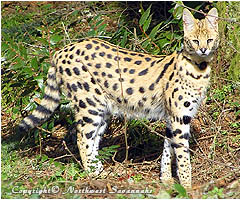 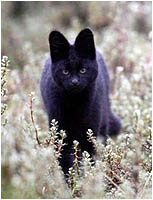 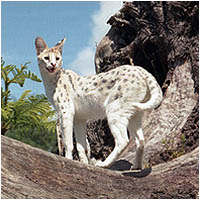
Inhabiting wetlands and grassy savannahs (although melanistic servals are usually found in mountainous areas) the serval is able to climb and swim, but it seldom does so.
As part of its adaptations for hunting in the savannas, the serval boasts long legs (the longest of all cats, relative to body size) and large ears. The long legs and neck allow the serval to see over tall grasses, while its ears are used to detect rodents, even those burrowing underground. While hunting, the serval will pause for up to 15 minutes at a time to listen with eyes closed. Their pounce is a distinctive vertical 'hop', which may be an adaptation for catching flushed birds. The serval is a highly efficient hunter, catching prey on as many as 70% of attempts, compared to ten % for most species of cat. The serval may also dig into burrows and fish the unlucky inhabitants out. Although the serval is highly specialized for catching rodents, it is an opportunistic predator whose diet also includes hares, hyraxes, birds, reptiles, insects, fish, and frogs The serval has been observed taking larger animals, such as small antelopes, but over 90% of the serval's prey weighs less than 200g (7 oz).
The gestation period for a female serval is 66-77 days. The litter consists of two or three young (called kittens), sometimes as few as one or as many as five. They are raised in sheltered locations like abandoned aardvark burrows. If such an ideal location is not available, a place behind a shrub may be sufficient. The serval is sometimes preyed upon by the Leopard and other large cats. More dangerous for this cat are humans. The serval was extensively hunted for its fur. It is still common in West and East Africa, but it is extinct in the South African Cape Province and very rare north of the Sahara.
Servals have a much wider range of vocalization than the domestic cat. In addition to the purr, servals hiss frequently. Not just when they are angry or upset but also to say "hey, here I am", "I'm confused", "look at what I just did!", "Iím sad", "I'm bored", etc. Their hiss is simply one of many verbalizations and expresses a wide range of opinions and moods.They also make a low grumbling sound that those unfamiliar with the cat would interpret as a warning. In fact, it is their form of "talking" and they can carry on for quite a while, seeming confused when their owners do not understand what is being communicated.
Servals also chirp like a bird. They do this most frequently in greeting when they see you approaching or they are coming to find you to "share" their excitement with a new pinecone toy, etc. This is a happy affectionate communication.
Servals are extremely active and agile. They can easily leap 10 feet from a sitting position and are remarkable problem solvers making them notorious for getting into mischief. They require large amounts of space to run and play. When kept as pets they are reported to have one of the most outgoing and friendly personalities of the wild cats and bond strongly to their owners. They have been kept as pets since Ancient Egyptian times, but in today's world are not good house pets because of their size, curiosity, hyperactivity, propensity for spraying and frequent refusal to use the litter box. Their lifespan is 20 years and they do not adaptable easily to environmental or family changes therefore, serval ownership is a long-term commitment and not one to approach casually. State, County and City laws require most owners to obtain special permits to own a serval here in the United States, and in some areas it is illegal to own one.

|











